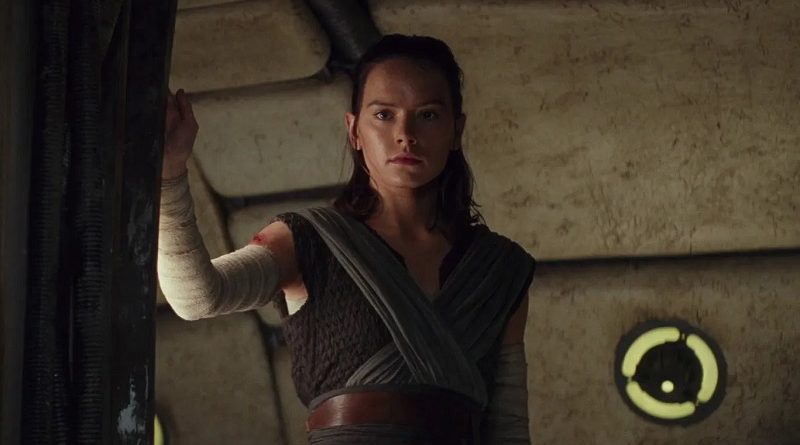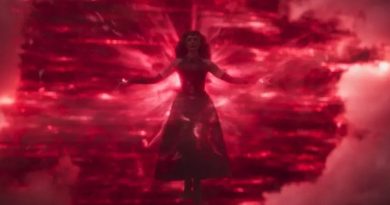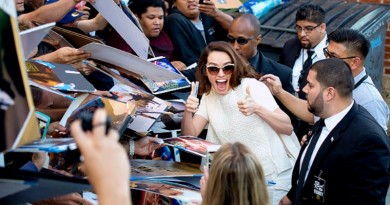Reconsidering Rian Johnson’s The Last Jedi After Knives Out
Undeniably, Rian Johnson’s The Last Jedi produced widespread disagreement upon its theatrical release in December 2017. Some considered it to be a brilliant film and a stellar contribution to the Star Wars franchise; others considered it to be deeply flawed as a film and an abject failure as a Skywalker Saga story. Some of the criticism of The Last Jedi has been insightful and perceptive, especially concerning how it handles diversity and inclusion, while other negative backlash was nothing more than shameless bigotry or bad faith trolling. Likewise, some of the praise for The Last Jedi was thoughtful and articulate, while others simply proffered reflexive support for the franchise or defensive posturing against bigots and trolls.
Based on data from Box Office Mojo, The Last Jedi grossed 92% of its total U.S. domestic box office through its first four weekends. By late January 2018, then, the vast majority of Star Wars fans, film critics, and members of the casual audience had formed their reactions to the film based on one or more viewings in the theater. The home video release and television broadcasts, and later the launch of the Disney+ streaming service, provided the opportunity to watch the film again, but first impressions are notoriously difficult to overcome. So if nearly two years later it appears that the passage of time has not changed very many people’s minds about the movie, it seems likely that such an assessment is accurate, too.
That The Last Jedi as a film remains unchanged, however, does not mean that the context in which we interpret the film also has stayed fixed. Within the context of the story, of course, the release of The Rise of Skywalker enabled evaluation of the Sequel Trilogy as a whole and the way its three constituent components interact, for better or for worse, in creating the aggregate tale – which I have previously written about extensively. Similarly, the release of Episode IX lifted some of the veil of secrecy surrounding the production process for the trilogy, providing additional insight into creative decisions that previously had been shrouded in mystery – which I will address in upcoming posts. Finally, Rian Johnson’s subsequent movie necessarily shed more light on the filmmaker as well as the themes and values included, consciously or unconsciously, within his body of work – which is the topic of this post.
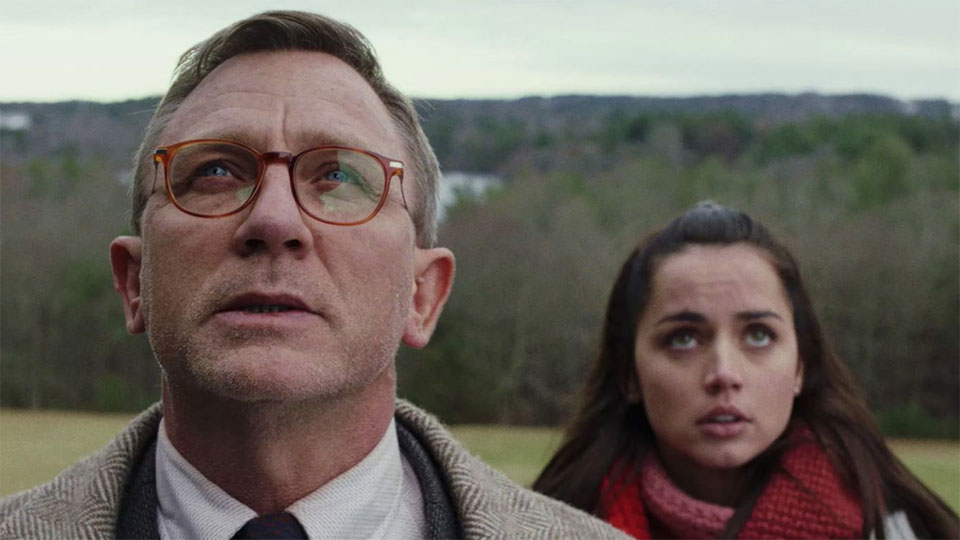
Story Similarities in Knives Out (2019) and The Last Jedi (2017)
In terms of genre and style, The Last Jedi and Knives Out are obviously quite different: the former is a Star Wars movie, with all that entails, and the latter is a murder mystery set in the contemporary real world, complete with timely idioms and pop culture references. Yet the two movies also share a wide range of consistent traits of Rian Johnson’s filmmaking, including extensive homages to works that inspired him and reliance on tropes and conceits suitable to those inspirations, while also breaking convention for how those elements might be expected to interconnect or pay off. Even more, when it comes to the underlying story told, Knives Out and The Last Jedi have far more in common than any other pair of Johnson films.
Although other characters convey the story, both Knives Out and The Last Jedi have the same central question: how did things go tragically wrong for the patriarch? In Knives Out, was Harlan murdered or did he die by suicide; in either case, what led to that tragedy? In The Last Jedi, what led Luke to become a lonesome exile from his family, his duty and destiny, and even the Force itself? Knives Out begins with Harlan’s death, and unfolds why it happened; The Last Jedi ends with Luke’s death, after unfolding why it will happen. The patriarch initiates a family conflict that precipitates the tragedy: Harlan’s disinheritance of Ransom leads his grandson to switch the bottle labels and thereby the fateful misunderstanding; Luke’s confrontation with his nephew leads to the rise of Kylo Ren. (Interestingly, Claudia Gray’s novel Bloodline – which was publicly described as incorporating ideas from Johnson’s development of The Last Jedi – implied that an important early step in Ben Solo’s fall to the dark side was the shocking discovery of a family secret through the public revelation of Leia’s and Luke’s father as Darth Vader by a politician named Ransolm Casterfo, but subsequent stories did not develop that element any further.) Each patriarch uses their final fatal act to protect their protégé: Harlan believes a cause of death of suicide will shield Marta from prosecution for negligent homicide, while Luke’s astral projection distracts Kylo Ren long enough to enable Rey and the Resistance to escape Crait. But the patriarch’s self-sacrificial demise could have been avoided if only they had listened to their young woman protégé: Harlan would have learned he was not in fact injected with a fatal dose of morphine if he had let Marta call an ambulance; Luke would have lived if he had listened to Rey about the necessity of ending his exile and returning to the life of a Jedi Master. And in the end, both patriarchs bestow their inheritance and legacy upon that outsider to the family rather than their kin: Harlan’s will bequeaths his entire estate to Marta, and Luke proclaims that Rey will be the last Jedi.

The two movies also share the same villainous motivation: a disaffected and cruel grandson who craves what he perceives to be his family’s legacy and is willing to kill to inherit it. For Ransom, the inheritance is literal: he seeks his rightful financial share (if not more) of Harlan’s estate. For Kylo Ren, the possessiveness for his grandfather’s lightsaber may be literal, but his broader goal is symbolic: to finish what Vader started by eliminating the Jedi and ruling the galaxy. Both Ransom and Kylo try to convince their rival to forsake being the sole heir instead, with Ransom offering to help protect Marta from prosecution in exchange for his share of the wealth and Kylo Ren encouraging Rey to let the past die and join him in leading the First Order.
It might seem that Marta and Rey are the central protagonists in the respective films, but the reality is that neither young woman has much agency in the story – both are passengers in a story driven by the men around them. Just as Rey’s choices are confined by the options presented to her by Luke and Kylo, Marta is set up by Ransom, then follows the cover-up scheme devised by Harlan, then responds reactively to the course of Blanc’s investigation. Both young women are duped by a malicious grandson who pretends to want to help them (Ransom in the café and Kylo in the hut), luring them into a direct interaction (Ransom and Marta in the car, Kylo and Rey aboard the Supremacy), but who actually is manipulating them into serving his own scheme (Ransom to gain his inheritance, Kylo to seize the throne as Supreme Leader with Rey joining him on the dark side). In the denouement of each film, the young woman plays only a small role while the primary showdown concludes between two men: Marta contributes one lie amid Blanc’s minutes-long victorious exposition exposing Ransom as the homicidal mastermind; Rey is nearly absent from the Battle of Crait while the film centers the climactic confrontation in which Luke Skywalker outwits Kylo Ren. While the young women prevail over their nemeses, it occurs because Blanc and Luke demonstrate why they are legendary figures.

The issues run deeper than the main characters, as well. Knives Out introduces Detective Elliott, played by Lakeith Stanfield, as the investigator of Harlan’s death, though he is quickly demoted in importance to focus on Daniel Craig’s Benoit Blanc. The Last Jedi similarly demotes John Boyega’s Finn, who undertook a Hero’s Journey parallel to Rey’s in The Force Awakens but whose character arc in the second film is largely repetitive and whose subplot is one of three used to illustrate the movie’s principal theme of failure. In each film, the female characters other than the protagonist (Marta and Rey) are archetypes or foils, but none of them has a character arc of their own, whether Leia, Holdo, Rose, or Phasma in The Last Jedi or Linda, Joni, Meg, or Fran in Knives Out. Both movies default to racist tropes to show that the bad guys are bad: undocumented immigrants and the Thrombeys, having Finn slapped across the face while kneeling in front of Hux. And both movies treat the threat of radicalized young men aligned with the alt-right (Jacob Thrombey and General Hux) as the butts of joke played for laughs, rather than as a serious danger. Johnson seemingly fancies himself as a critic of privilege, power, wealth, and greed in The Last Jedi and Knives Out, but the films struggle at making that critique feel genuine.
Knives Out and Rian Johnson’s Filmmaking
In addition to insights gleaned from the nature of its story, Knives Out reiterates a number of aspects to how Rian Johnson operates as a storyteller in the medium of film. Most importantly, Johnson does not present his films from the perspective of an omniscient observer, but rather tightly constrains the manner in which the viewer experiences the story, frequently by relying on the limited knowledge and point-of-view of particular characters. Such techniques are inherent in mystery stories like Brick and Knives Out, where keeping the audience in the dark about the true nature of the events under investigation is a necessary conceit of the genre. But Johnson uses them in his other films, too, including The Last Jedi.
Many of the twists and reveals in The Last Jedi and Knives Out depend on the characters misjudging or deceiving one another. Marta initially hides from Blanc the truth about her role in Harlan’s death. Ransom believes he has successfully persuaded Marta to his plan. Meg pretends to offer support to Marta, but is really acting at the behest of her family. Poe’s entire subplot depends on his skepticism and mistrust of Admiral Holdo. Rose initially detests Finn, and over time sees the better side of him. DJ helps them escape Canto Bight, but ultimately sells them out in an act of self-preservation.
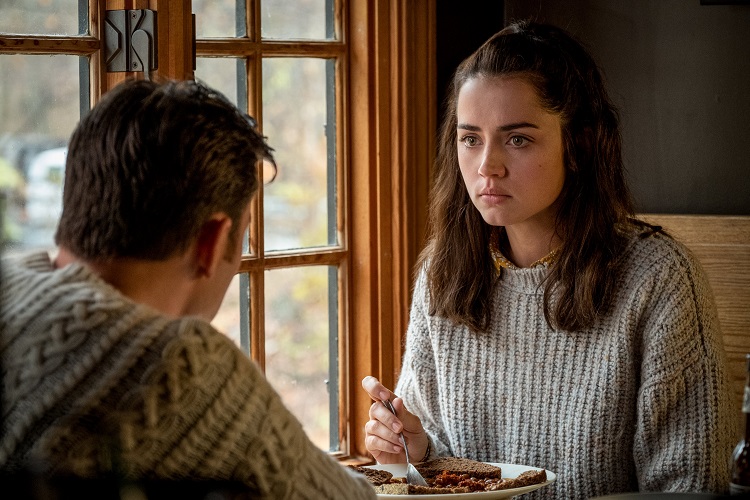
Through this lens, Knives Out reinforces the importance of paying careful attention to the presence of emotional manipulation in The Last Jedi, both between the director and the audience and between Kylo Ren and Rey. Though each has scenes without the other, all of their direct interactions are portrayed onscreen through Rey’s point-of-view. In a 2019 interview, for example, Johnson disclosed that the music John Williams originally had written for the hand-touching scene in the hut was too ominous, and that Johnson persuaded the composer to change the music to the generic Force Theme to preserve the audience’s location in Rey’s point-of-view and retain the feeling of possibility rather than danger in the moment. Johnson used this storytelling technique because the climactic twist in their interactions – that Kylo rejects the opportunity to return to the light in the Supremacy throne room and instead insists Rey join him on the dark side – would not work narratively unless Rey had personally felt reasons, not simply Luke’s past example with Vader or a momentary glimpse in a Force vision, to believe and expect the opposite to occur. For the twist to succeed, Johnson’s film must not only trick Rey, but through her eyes the audience, as well.
More broadly, Knives Out serves as a reminder that Johnson is deliberate and precise in the homages and tropes he places within his films. Among his five films to date, only one of them (The Brothers Bloom) includes an overtly romantic relationship that blossoms over the course of the story. Among the works of classic cinema that Johnson screened for his Episode VIII “film camp” early in its development, none are romances – and several are war films with literally no meaningful female characters. Nonetheless, some fans interpret The Last Jedi as containing a romance storyline, such as positioning Kylo as a Byronic hero or perceiving an allegory of Rey’s youthful sexual awakening within its imagery. Such readings are at odds with Johnson’s cinematic inspirations as well as Kylo Ren’s character arc in the film to become the risen dark side menace whom Rey must counter from the light side by becoming the last Jedi. Likewise, Rey’s shattered expectations are easily viewed as a classic non-romantic mythic trope: the hero betrayed by the very person in whom they had placed the greatest hope and trust, such as Arthur and Lancelot, Julius Caesar and Brutus, Othello and Iago, or Obi-Wan and Anakin. (That said, literary, television, and cinematic precedent does include a similar trope of more overtly sexual significance, where an innocent ingénue is betrayed or discarded by the man she believed loves her shortly after their first act of intimacy.) Regardless, Rey unambiguously ends the film angry and disillusioned by Kylo’s repudiation of the faith and confidence she had placed in him.
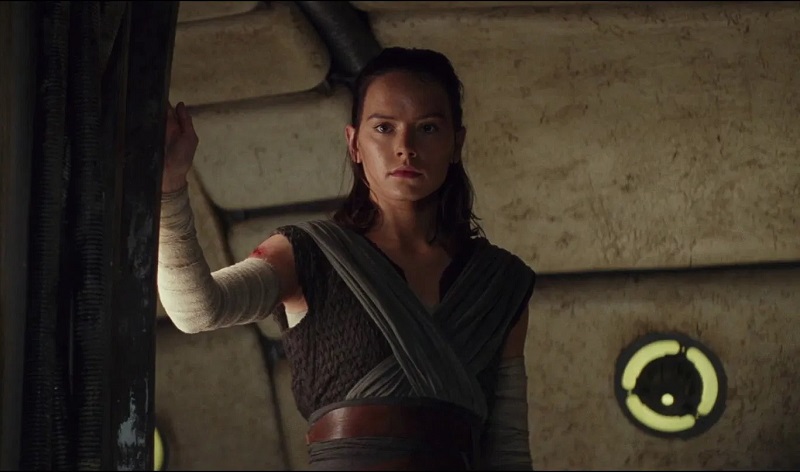
In the cinematic language Johnson uses, the final moment between the characters in The Last Jedi is not one of possibility or potential, but severance. As Dan Golding writes in Star Wars After Lucas (p.202-203), “Johnson’s use of the closing ramp is a film reference in a long line of film references” from The Searchers and The Godfather to Kill Bill, to symbolize the definitiveness of Rey’s action. “She might once have admitted the man she optimistically saw as Ben Solo, but Rey will no longer welcome a man like Kylo Ren. There once were alternative for Kylo, a chance for redemption and salvation, for building a life back within the shelter of civilization – but no more. In one move, Johnson borrows from cinematic history, amends it for a galaxy far, far away, and sets the scene for Episode IX.” Knives Out ends with a similar moment of stark separation, with Marta comfortably robed atop the mansion balcony, sipping from Harlan’s mug, while the disinherited and evicted Thrombeys stand dejectedly out in the literal and metaphorical cold.
Knives Out and Rian Johnson’s Star Wars
One notable aspect of The Last Jedi was the diversity of its cast. Advocates of improving inclusion in Hollywood generally praised the progress seemingly signified by the new significant cast members announced for the film (including Benicio Del Toro, Laura Dern, and Kelly Marie Tran). Upon its release, however, many critics and commentators noted that the actual heft of those roles in the completed film had failed to reach their potential, as well as the detrimental ways in which the movie portrayed and sidelined the two men of color (Finn and Poe) in favor of a newfound emphasis on the two white characters (Rey and Kylo Ren) from the principal cast of The Force Awakens. Earlier this week in an interview published by British GQ, John Boyega expressed the same sentiment from his own perspective and experience inside the creation and production of all three Sequel Trilogy films. Ironically, bigots and trolls likewise cited cast member diversity as a negative attribute of the film, in service of various hateful and divisive agendas. Amid disagreeing perspectives on its significance and value, the presence of cast member diversity in The Last Jedi was essentially unquestioned by everyone.
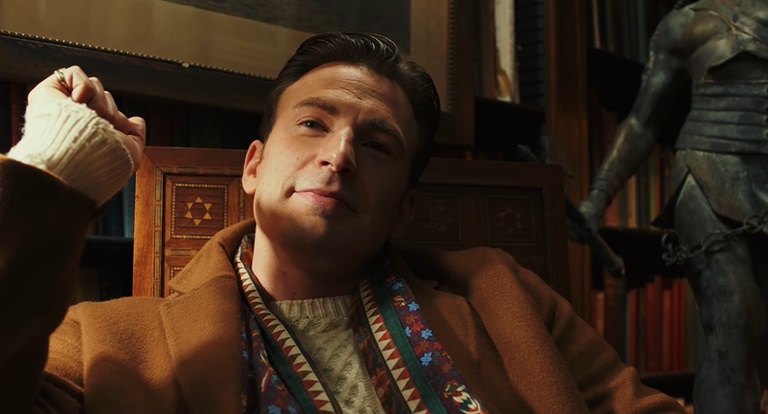
Yet with Knives Out, Johnson promptly reverted to a cast and a story that far more closely resembled his previous films: a story centered on one or more troubled white men, mostly surrounded by other white people. In light of Brick, The Brothers Bloom, Looper, and Knives Out, there can be little wonder why Johnson found Kylo Ren – not Rey or Finn – to be the most interesting new character launched by The Force Awakens and why he accordingly elevated Kylo to a “co-protagonist” with Rey rather than allowing her to remain the pivotal character in her trilogy as Luke and Anakin did. It also raises questions about how Johnson might have envisioned Kylo Ren’s story arc to end in Episode IX, had his ideas shaped the trilogy’s concluding episode more directly.
Looking back to Looper, some fans have suggested thematic similarities between Kylo’s story in the Sequel Trilogy and crucial dialogue from Young Joe. He explains his fateful choice with voiceover: “Then I saw it. I saw a mom who would die for her son. A man who would kill for his wife. A boy, angry and alone. Laid out in front of him, the bad path. I saw it. And the path was a circle. Round and round. So I changed it.” Perhaps, despite his numerous dark deeds in The Force Awakens and The Last Jedi, Johnson might have had in mind that Kylo Ren could find the strength to break the cycle in the third film. Shortly before the release of The Last Jedi, Johnson expressed the following sentiment about the character: “But I don’t think it’s very interesting if the whole story is just ‘Will Kylo get his comeuppance?’ He’s a more complicated character than that and I think he deserves a more complicated story than that. I don’t see the point of trying to get behind his mask and learn more about him if all we’re going to learn is ‘Yeah, he’s just an evil bad guy that needs to be killed.’”
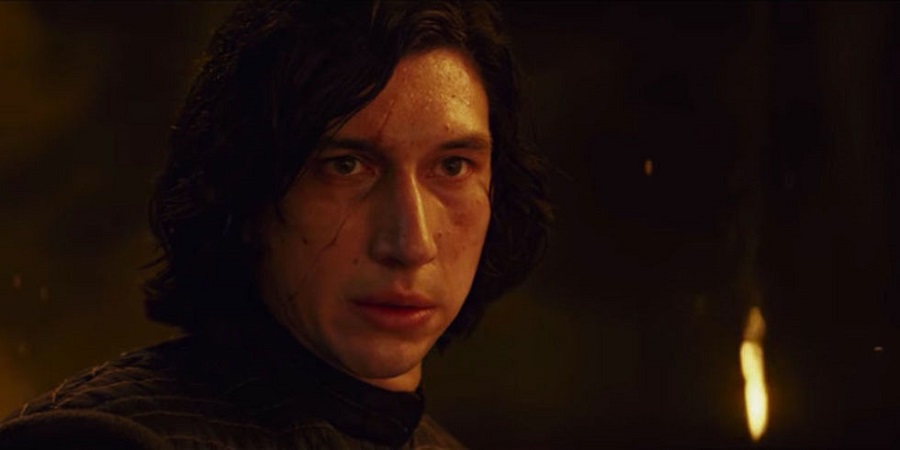
But after Knives Out, it seems entirely possible that Johnson might have had a very different ending for Kylo Ren in mind. In a movie with similar themes of toxic privilege and resented legacies, Johnson wrote an ending all about comeuppance. Every single one of the Thrombeys is denied what they wanted most: millions of dollars, control of intellectual property, the mansion. Their desires are fully thwarted and Marta, the kind and compassionate caregiver, is rewarded with everything they craved. And in the final scene, she makes sure they know it. Maybe Johnson would have given Rey the same legacy mantle and Kylo Ren the same empty and defeated comeuppance. Because another similarity between The Last Jedi and Knives Out is the cautionary warning they deliver with Adam Driver’s Kylo Ren and Chris Evans’ Ransom Drysdale: rather than the obviously evil and corrupted menace, sometimes the handsome and charming child of privilege is the most dangerous villain.
.
Related Links:
- The Last Jedi’s Unexpected Star Wars Story Structure (Dec. 2017)
- The Last Jedi and the Hero’s Journey – Part One: Rey (Jan. 2018)
- The Last Jedi and the Hero’s Journey – Part Two: Finn (Jan. 2018)
- The Last Jedi and the Hero’s Journey – Part Four: Kylo Ren and the Villain’s Journey (Feb. 2018)

